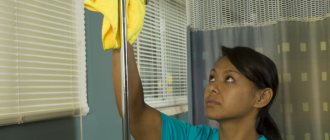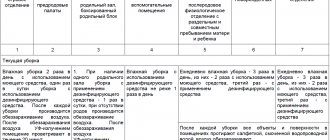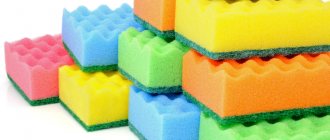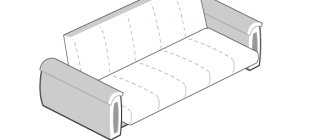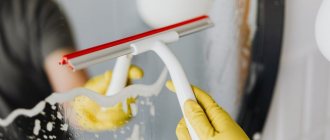Cleaning in a hospital is a constant process, since we are talking about a medical institution where the requirements for disinfection, asepsis and antiseptics are very high. According to sanitary and epidemiological standards, each hospital room should be cleaned using a certain technology using disinfectant solutions and cleaning equipment allocated individually for each room.
- Types of hospital cleaning
- Cleaning rooms in a hospital
- Cleaning corridors in a hospital
- Hospital cleaning solutions
Routine and general cleaning in a medical facility can only be carried out by specially trained and qualified personnel.
Features of wet cleaning
Compliance with sanitary standards plays a vital role in the work of a hospital. If they are disturbed, pathogenic bacteria can enter a favorable environment for reproduction. For example, thanks to wet cleaning of rooms, you can get rid of dust. And it is known to contain many bacteria that cause diseases.
A special feature of cleaning in medical institutions is the use of special disinfectants.
Wet cleaning of rooms should be carried out at least twice a day. The first time - before 9 am, so that the ward is prepared for the doctor’s rounds. Evening is the best time for the second cleaning. Because the visit to patients is over, there are no strangers, and it is possible to thoroughly disinfect the room.
Gloves and special uniform are required when wet cleaning rooms.
Final disinfection
Various types of cleaning in healthcare facilities are combined to achieve comprehensive care of the premises. Final disinfection is carried out after patients are discharged or die. This is done in special clothing. Everything is processed: from bedding to equipment and the entire room. This type of cleaning is carried out by sprinkling or wiping ceilings, walls, and beds. Be sure to wash the floor using a disinfectant solution. According to the list, in addition to cleaning, the room can be quartzed.
Solutions and tools
A special block is allocated for storing cleaning equipment in hospitals. All tools are used strictly for their intended purpose and are stored in a special room. Items should be numbered, indicating rooms and types of work, or color-coded. It is usually stored in a block along with the tools.
Most often, when wet cleaning rooms, disinfectants are used, which are produced in the form of a concentrated solution. To use them, you need to dilute them with water in accordance with the universal table, which can be found in the instructions for each product. It indicates the mixing proportions of the working solution, and what concentration is needed to process things under different modes. The table is stored in the same block as the rest of the inventory.
The concentration of the solution during disinfection is observed according to the regime in force in the medical institution. Rooms with different regimes have their own means of disinfection and cleaning. For example, in rooms with bacterial diseases, a less concentrated solution is used than for viral diseases.
When mixing compounds, be sure to protect your hands by wearing gloves.
In addition to modern disinfectant concentrates, you can use products prepared independently:
- 0.5% solution of soda and soap. 25 grams of planed soap and 25 grams of soda are diluted in water (11 liters).
- Special agent "Chloramine". 500 grams of the composition are diluted in water (11 l.).
- Composition of peroxide. A 6% solution with 0.5% detergent composition is diluted in water (11 l.).
- For mold, use “Lizorin.” 25 ml of the composition is diluted in water (11 liters).
There is a special list of disinfectants officially approved by the Department of State Sanitary and Epidemiological Surveillance for use in hospitals. They must meet the following requirements:
- Kill bacteria, viruses, fungi. At room temperature, inhibit infection activity.
- Maintain the appearance of furniture, floors, and things.
- Possess not only disinfectant properties, but also cleaning properties.
- Do not harm the human body, be low-toxic.
- The products must pass fire safety specifications.
A new solution is prepared for each room. After completion of work, it is disposed of. It is impossible to allow several rooms to be cleaned with the same solution.
Dry cleaning equipment
Cleaning is not an easy task. Especially if the room is specialized and large in size. So that cleaning does not take too much time and does not require investment of effort, various tools and equipment come to the rescue. When carrying out dry cleaning, the following equipment is used:
- Dry wipes that can be used to collect dust without spreading it around. Dry cleaning is best done using microfiber cloths, artificial suede, and non-woven materials.
- Brushes and brooms: such tools are needed for cleaning not only indoors, but also outdoors. With their help you can collect fine dry dirt, sand, branches, leaves.
- Dust mops are the most convenient tool that is suitable for quickly cleaning a room and is hygienic and efficient.
- Mechanical sweepers are ideal for cleaning large rooms and areas, and they can easily cope with hard-to-reach areas. In most cases, various types of office cleaning are performed using such equipment.
- Vacuum cleaners: dry cleaning cannot be imagined without using a vacuum cleaner. This method is attractive due to its environmental friendliness, speed of the process, mobility and cost-effectiveness.
Cleaning according to SanPiN
Medical institutions have sanitary and epidemiological requirements approved by the chief state sanitary doctor and the SanPiN resolution. In accordance with the document, all activities related to the activities of hospitals are carried out, including wet cleaning of wards.
Instructions for cleaning personnel are carried out at least once a year. The organization and control of the passage remains with the LGO administration. Sanitary standards and technologies change quite often. And employees must be informed in a timely manner.
First, patients must be warned that the room will be cleaned. The orderly or nurse puts on:
- special clothing used only when cleaning (robe, cap, oilcloth apron);
- specialized shoes;
- gloves.
Inspects the ward, prepares disinfectant solutions separately for furniture and flooring.
The technique for wet cleaning of wards is also prescribed in the resolution:
- Ventilate the room while cleaning. If there are bedridden patients in the ward, wrap them in a blanket. Patients who are able to stand should leave the room.
- Wipe bedside tables and check their contents (perishable food should be refrigerated) - the first thing medical personnel should do.
- Then wipe the dust from the window sills, wash handles and other furniture from top to bottom, without touching the floor.
- Wash the floor with a diluted solution using a special mop from the wall and window to the doorway.
- Place trash in the hallway.
- Depending on the specifics of the wards, bactericidal lamps are turned on for the appropriate time
Containers with disinfectants are well closed and indicated:
- if there are no labels, write down the name of the product;
- level of concentration, purpose;
- date of preparation and expiration date.
For each product, it is necessary to provide storage conditions that meet the requirements.
After renovation or construction
There are certain types of cleaning that are required after completion of repair or construction work. After such large-scale operations, a lot of garbage accumulates, so many turn to professional cleaning companies. Their employees perform a whole range of work:
- collect and completely remove construction waste;
- clean all surfaces;
- remove dust from baseboards, heating systems, windows, etc., and then perform wet cleaning;
- clean and treat sanitary equipment with special products;
- wash the floors.
Thus, there are different types of cleaning services that can be used in offices, shops, homes or medical facilities. The quality of each operation depends on how well the instruments and the necessary means for its implementation are selected. Each room has its own method. And if general cleaning is carried out, then initial preparation is required. This allows you to think through the entire cycle of work. Particular care and accuracy should be exercised when caring for operating rooms, which are thoroughly disinfected with modern means.
Approved
by order of the Ministry of Health
No. 130 dated 17.03. 2006
Wet cleaning schedule
Healthcare units should have written cleaning schedules.
How often wet cleaning of wards should be carried out is prescribed in the SanPiN regulations. It is usually carried out at least twice a day. If necessary or under special conditions - more often.
Cleaning and quartzing schedules for each area are planned, written, signed, approved and posted. They indicate the time and object of cleaning, the name of the orderly or nurse. Where one or the other puts his painting at the end of the work.
What types are there?
There are a number of methods of general and routine cleaning used in clinics and hospitals. Namely:
- Physical. Boiling method, ultraviolet irradiation, steam disinfection.
- Mechanical. Cleaning with damp cloths, daily and regular hand washing by medical personnel.
- Chemical. By soaking in a disinfecting solution and completely immersing the required item.
There is also a combined one. Several methods can be used simultaneously or several methods can be used interleaved.
Preface
- 1 DEVELOPED by the Federal State Unitary Enterprise "Russian Scientific and Technical Center for Information on Standardization, Metrology and Conformity Assessment" () and the Joint Stock Company "Institute of Regional Economic Research" (JSC "IREI") with the participation of the Self-regulatory organization "Association of Regional Cleaning Companies" (SRO ARUK). Non-profit organization "Association of Russian Cleaning Companies" (ARUK). Non-profit organization "Association of Russian Cleaning Companies" (ARUC St. Petersburg) and with the support of the Department of Trade and Services of the City of Moscow
- 2 INTRODUCED by the Technical Committee for Standardization TC 346 “Household services for the population”
- 3 APPROVED AND ENTERED INTO EFFECT by Order of the Federal Agency for Technical Regulation and Metrology dated March 27, 2022 No. 109-st
- 4 INTRODUCED FOR THE FIRST TIME
The rules for applying this standard are established in Article 26 of the Federal Law of June 29, 2015 N9 162-FZ “On Standardization in the Russian Federation”. Information about changes to this standard is published in the annual (as of January 1 of the current year) information index “National Standards”, and the official text of changes and amendments is published in the monthly information index “National Standards”. In case of revision (replacement) or cancellation of this standard, the corresponding notice will be published in the next issue of the monthly information index “National Standards”. Relevant information, notices and texts are also posted in the public information system - on the official website of the Federal Agency for Technical Regulation and Metrology on the Internet (www.gost.ru)
Standardinform. decor. 2019
This standard cannot be fully or partially reproduced, replicated or distributed as an official publication without permission from the Federal Agency for Technical Regulation and Metrology
